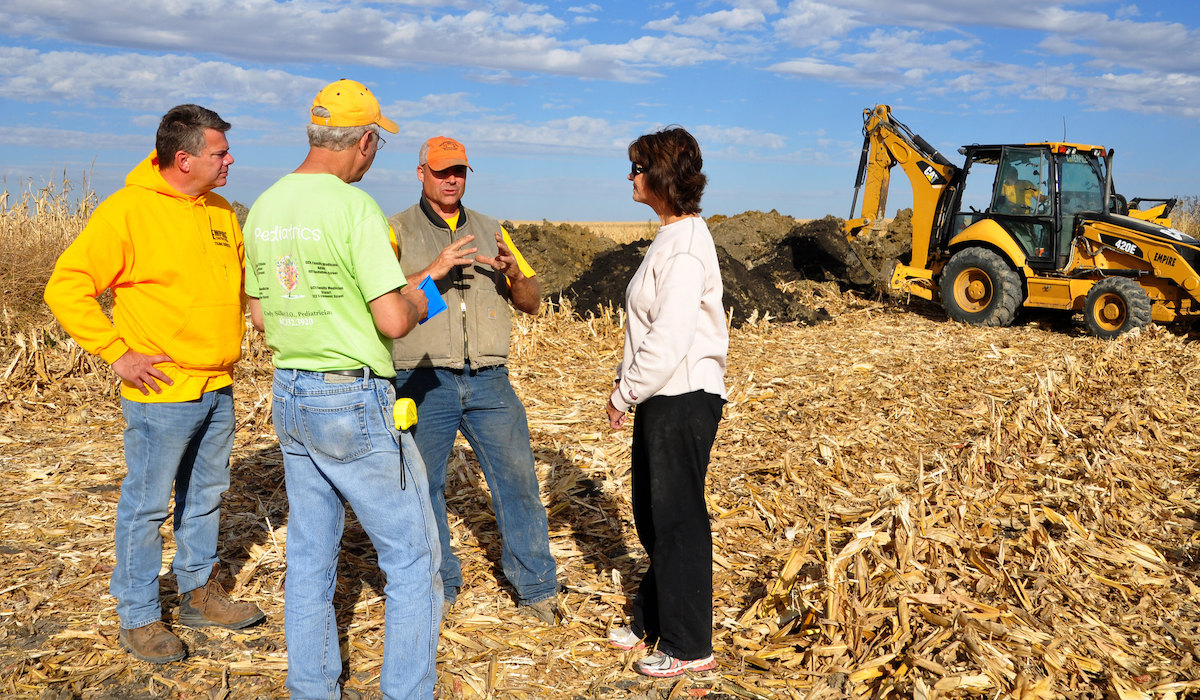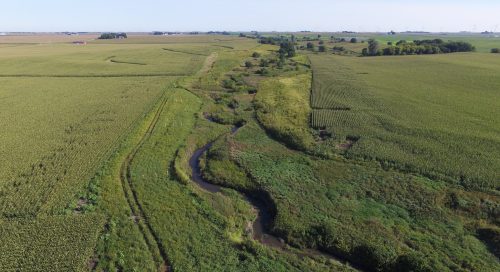By Joe Bonnell
My career in watershed management began in 1990 as an environmental education volunteer with the Peace Corps in Costa Rica. For two years, I worked with a group of teachers in a small town near the Panama border. The teachers had organized to address deforestation in the watershed that was the sole source of drinking water for the town of Palmar Norte.
At the end of my service, I left with a nagging sense that I could have been so much more effective in my role if I had had a better understanding of how to bring diverse stakeholders within a watershed together to create a shared plan for protecting their local water resources. The rest of my career in Extension – first at The Ohio State University as Program Director for Watershed Management and now as a Regional Natural Resources Educator in SW Wisconsin with UW-Madison Extension – has been dedicated to understanding how collaborative watershed management works and to supporting those who lead and participate in that process.
My intention with this article is to offer a sort of roadmap for readers who have taken on a similar mission to support the individuals and groups engaged in collaborative watershed management – who often work for government agencies, nonprofits, or university extension and, hereafter, I’ll call service providers – and to help you think strategically about the type of support you provide and how to provide it.
Before we get into the question of how we ought to be supporting collaborative watershed management, let’s get a shared understanding of what we’re talking about.
While it can take many forms, I’ll offer the following definition: collaborative watershed management is a process by which key stakeholders within a watershed work together to develop a plan that identifies and prioritizes non-point source pollution issues, as well as goals, objectives, actions and strategies to address those issues. It also involves the creation of social structures and processes to harness and coordinate the resources (human, financial, material) required to implement the resulting watershed plan.
By definition, collaborative watershed management means working with other stakeholders with whom you may not share the same values and goals, dealing with highly complex human and natural systems, making difficult decisions with incomplete data, and attempting to persuade other groups and individuals to change their land management practices. All of this requires a unique suite of skills that I lump into the following four broad categories to call attention what is required for success:
Collaborative processes
Collaboration requires bringing multiple stakeholders together to identify shared goals and work together toward achieving them. This is not how most individuals or organizations function day-to-day and so requires an effective group process to facilitate communication, shared learning, conflict management, and decision-making.
Groups that undertake collaborative watershed management without an appreciation for the importance of effective group process often flounder or end up settling on solutions that require very little change in the status quo, only because they’re the only ones on which everyone can agree.
Skilled facilitators in a collaborative process can come from inside or outside the initiative. In my experience, successful initiatives require skilled facilitators who can utilize a diversity of group processes to help participants learn to work together to make meaningful change.
Organizational leadership and management
Not every collaborative watershed management initiative results in the formation of a stand-alone organization, but many do. Because watershed management requires multiple parties to engage in a long-term strategy, the formation of a new organization to oversee the process makes sense in many instances.
But, even when organizations are relatively small and informal, they require leadership and management.
Effective organizations have a leadership structure and rules or guidelines for making decisions. As groups get more sophisticated, they may begin managing money, hiring contractors and staff, and administering grants to fund implementation projects.
Some organizations happen to have leaders with organizational leadership and management experience, but many don’t.
Watershed planning
Comprehensive watershed plans are complex documents, covering a wide range of topics, from characterization of the natural resources, social and economic assessments, water resource and water quality data, identification of causes and sources of water quality impairments, identification and prioritization of critical areas and remediation strategies, responsible parties and timelines – the list goes on!
In collaborative watershed management, leaders often look to a small sub-group of collaborators – typically local government or university technicians with watershed planning expertise – or external consultants to handle the technical aspects of watershed planning. But even if other key stakeholder groups aren’t directly involved in gathering and analyzing data, they should be engaged in the aspects of the planning process that involve identifying and prioritizing water quality issues and remediation strategies.
If I have learned anything from my twenty-plus years of experience in watershed planning, it is that the likelihood of implementation of a plan is directly related to the level of engagement of key stakeholders in the development of that plan.
Project management
After the planning comes the implementation. Plans that don’t get implemented have repercussions beyond the impacts on water resources.
When stakeholders invest their time and resources in the planning process only to see the resulting plan get filed away, they lose trust in the collaborative process. That lost trust can be difficult, if not impossible to recover.
For implementation to happen, programs and projects have to get done. Whether they involve outreach programs to encourage farmers to adopt conservation practices or stream restoration projects, programs and projects are where the rubber meets the road.
This is not even a complete accounting of the skills required by leaders and participants in collaborative watershed management, but it does hopefully give the reader a sense for the wide range of skills and services required to support it.
Now let’s turn to the question of how we, as service providers, should invest in people to support collaborative watershed management. I’ll offer some questions for service providers to ask themselves before making those investment decisions.
Should you work from the inside or outside?
Would you be better off supporting that initiative from the inside, as a participant in the planning process, or from the outside as an advisor, consultant, or contractor? The answer depends partly on your organization’s investment in the outcomes of the planning process.
The more the outcomes will affect your organization’s interests, the greater the incentive to participate directly in the process. But if your interests are not at play, you may provide your services in an advisory or consulting capacity.
Many government agencies, for example, prefer not to take on leadership roles in collaborative watershed management processes to avoid the appearance of pitting agency goals and priorities against those of community stakeholders.
Regardless of whether you choose to support the process from the inside or outside, the most important rule of thumb is to be clear about which approach you are electing.
How much support should you provide and for how long?
Some collaborative watershed management initiatives have the good fortune to include agency, university, and non-profit organizations with extensive resources to support watershed planning and implementation. This is particularly true in urban and suburban communities.
When local capacity is high, investment in an initiative may focus primarily on the efficient division of labor to determine which entities will oversee which aspects of the planning process and who will be responsible for implementing priorities.
This situation of an abundance of resources is the exception, rather than the rule. This is especially true in rural areas, where there tend to be fewer local agencies and non-profit organizations focused on water resources, and both tend to have few staff and modest budgets.
In these instances, local government, university extension, and non-profit organizations will most likely need to assume leadership of the initiative for the long-term. Other stakeholder groups, such as farmer-led watershed groups, can be vital allies in developing strategies for promoting the adoption of conservation practices among their peers. But, in my experience, most farmer-led and other citizen-based watershed groups do not have the capacity to oversee the many demands required to lead collaborative watershed management initiatives.
How much effort should be placed on building local capacity for collaborative watershed management?
There’s an oft-repeated saying, “If you give a hungry man a fish, you feed him for a day. If you teach him to fish, you feed him for a lifetime.” When local capacity is lacking, is it better for external organizations to invest their resources in building local capacity through training and educational programs or to fill the need by providing the service directly?
For example, if the board of a farmer-led watershed group is interested in pursuing a grant to fund cost-share for cover crops, should the local Soil and Water Conservation office apply for the grant or hold a training for farmer leaders to learn how to write a competitive grant proposal?
As with everything watershed-related, it depends.
First, if you are the external organization, do you have the resources to provide the service for the period of time they will be required? If not, it might be best to offer the service on the condition that you mentor one or more of the local leaders, so they can eventually assume responsibility for the service.
Second, does the local group have the capacity to conduct the service with internal resources consistently over time? If not, the initiative may be dependent on an external service provider.
In Ohio, for example, the state Department of Natural Resources provided grant funds to support full-time watershed coordinators to lead local collaborative watershed management initiatives. The grants were designed to reduce state funding for the positions gradually over time, with the intention that the local stakeholders would find other sources of funding.
The watershed initiatives that were led by local governments were much more successful at raising funds to maintain the watershed coordinator positions than groups that were largely citizen-led. Several service providers, including myself, held workshops for citizen watershed group leaders to help them become better fundraisers, but very few of these citizen-led groups were ever able to raise enough funds to hire a full-time watershed coordinator.
Hopefully by now it’s obvious that, to be effective, collaborative watershed management requires huge investments in those who undertake it, to enable them to apply a diversity of skills in both the natural and social sciences, collaborate with multiple stakeholders, and sustain that effort over a long period of time.
Building local capacity through training and educational programs is one important strategy to invest in people, but to scale up collaborative watershed management to the majority of impaired watersheds in the Mississippi River Basin, particularly in rural and economically disadvantaged areas, more is necessary.
Local government, nonprofits, and university extension who support these initiatives must be prepared to make significant, long-term investments in building local capacity or provide the resources and support services required by local stakeholders directly. And there must also be more investment that enables service providers to sustain their support.



